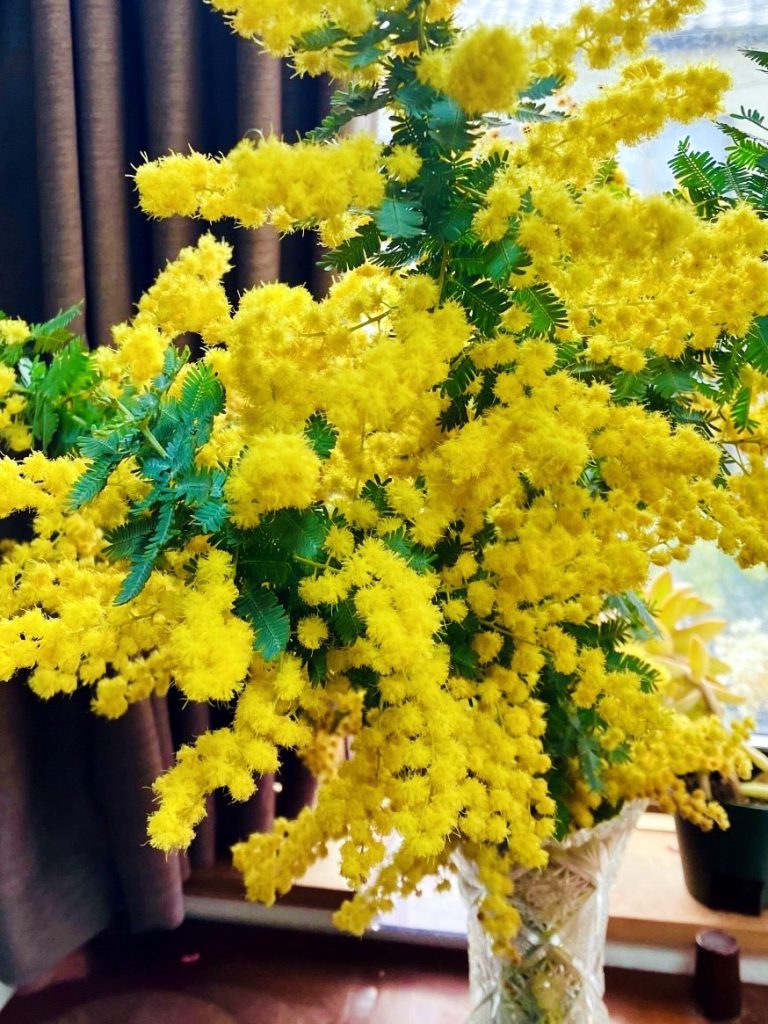
The confusion over flower names is truly perplexing. The flower in the photo is an Acacia, specifically the Mimosa Acacia. There’s another Acacia known as the Silver Acacia. While Mimosa Acacia leaves are green, those of the Silver Acacia, true to its name, have a slight silvery hue. Interestingly, the Acacia in the popular song ‘When the Acacia Rain Stops’ from the 1960s, during the ANPO protests, is actually a False Acacia, originating from North America, with entirely different flower shapes. Another common mistake is confusing Acacia with Mimosa. Acacia originates from Australia and was used by the Aboriginal people there for declarations of love. When Acacia was introduced to France, it was initially called ‘Acacia resembling Mimosa,’ eventually leading it to be referred to as Mimosa. Mimosa, also known as Bowing Acacia, as its name suggests, bows its leaves when touched, unlike Acacia. Additionally, while Acacia blossoms yellow, Mimosa blooms pink flowers. March 8th is International Women’s Day, symbolized by the Mimosa, hence also known as ‘Mimosa Day.’ On this day, it’s customary for men to present fresh Mimosa to women they appreciate. Although this tradition has recently taken hold in Japan, the ‘Mimosa’ often gifted is usually Acacia, perhaps due to the lingering influence of Aboriginal customs.
花の名前も真偽合い乱れて本当にややこしいですね。写真の花はアカシアで、それもフサアカシアです。アカシアには銀葉アカシアと言う別のアカシアがあります。フサアカシアの葉は緑色ですが、銀葉アカシアの葉はその名の通りやや銀色がかっています。1960年代、安保闘争の頃に流行った流行歌の「アカシアの雨のやむとき」のアカシアは実はニセアカシアで、原産地は北米、花の形状も全く違う別品種です。またよくアカシアをミモザと言う人がいますが、これも間違いです。アカシアは原産地がオーストラリアで、そこの先住民であるアボリジニが愛の告白をするときに使いました。そのアカシアがフランスに持ち込まれた時、「ミモザに似たアカシア」と呼ばれている内にいつしかミモザになってしまったのです。ミモザはオジギソウとも呼ばれ、その名のとおり、葉っぱに触れるとお辞儀をしますが、アカシアは葉っぱに触れてもお辞儀をしません。またアカシアの黄色に対し、ミモザはピンク色の花が咲きます。3月8日は国際女性デーで、そのシンボルが「ミモザ」と言うことで「ミモザの日」とも呼ばれます。この日に男性から普段お世話になっている女性に、旬のミモザをプレゼントする風習があります。日本でも最近はこの風習がかなり定着してきましたが、贈る「ミモザ」は大概アカシアです。アボロニジの風習が伝承されてきた名残りかもしれません。
